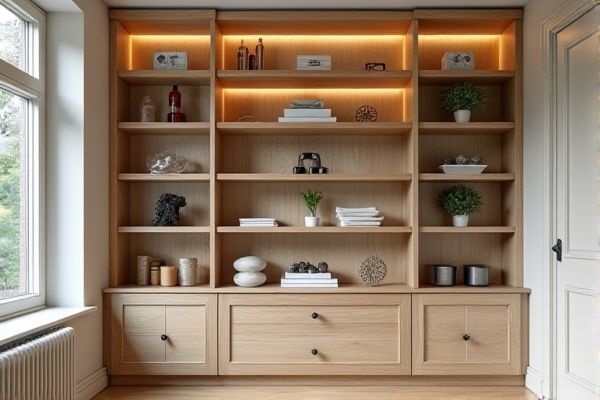
Swing-out shelves offer easier access to items in corner cabinets by pivoting outward, maximizing storage space without requiring full extension. Pull-out shelves slide straight out, providing a clear view and reach to the contents but may need more room to open fully--discover which option suits Your kitchen layout best by reading the rest of the article.
Table of Comparison
| Feature | Swing-Out Shelves | Pull-Out Shelves |
|---|---|---|
| Accessibility | Swings out to the side, allowing side access | Slides straight out, providing full front access |
| Space Efficiency | Requires clearance on the side to swing open | Utilizes cabinet depth without extra side clearance |
| Installation Complexity | Moderate; includes hinges and brackets | Moderate; involves sliding rails |
| Load Capacity | Suitable for light to medium loads | Handles medium to heavy loads efficiently |
| Best Use Case | Corner cabinets or hard-to-reach side spaces | Deep cabinets requiring full access |
| Price Range | Generally affordable to mid-range | Mid-range to premium depending on hardware |
Introduction to Swing-Out and Pull-Out Shelves
Swing-out shelves pivot outward, providing full access to items stored at the back, making them ideal for corner cabinets and maximizing hard-to-reach spaces. Pull-out shelves slide straight out, allowing you to easily view and reach all contents without bending or stretching, perfect for pantry organization and deep cabinets. Choosing between swing-out and pull-out shelves depends on your kitchen layout and the ease of access you require for your storage needs.
Key Differences Between Swing-Out and Pull-Out Shelves
Swing-out shelves pivot outward on hinges, providing full visibility and access to items without having to remove other objects, making them ideal for corner cabinets. Pull-out shelves slide straight out on tracks, maximizing storage space and offering easier access to the back of deep cabinets, commonly used in pantry or base cabinets. The primary difference lies in their movement mechanism and optimal cabinet application: swing-out shelves swing open laterally, while pull-out shelves extend linearly.
Design and Mechanism Comparison
Swing-out shelves feature a pivot mechanism that allows the shelf to rotate outward, providing easy access to items stored deep within cabinets, ideal for corner spaces. Pull-out shelves operate on sliding rails that extend horizontally, offering full visibility and reach across the entire shelf surface, making them suitable for pantry or deep storage units. Both designs maximize storage efficiency but differ in space requirements and accessibility, with swing-out shelves requiring lateral clearance and pull-out shelves needing front clearance.
Space Efficiency and Storage Capacity
Swing-out shelves maximize corner cabinet space by allowing deeper access to items stored in the back, enhancing storage capacity without expanding your kitchen footprint. Pull-out shelves provide straightforward access by sliding forward, making them ideal for narrow or linear cabinets where space efficiency is crucial. Your choice depends on balancing ease of access with optimal use of available storage volume.
Accessibility and Ease of Use
Swing-out shelves offer superior accessibility by smoothly pivoting outward, allowing users to reach items at the back without bending or stretching. Pull-out shelves slide straight out, providing a straightforward approach to access stored items but may require more effort to reach deeper corners. Both designs enhance ease of use, but swing-out shelves are often preferred for maximizing visibility and convenient retrieval in tight spaces.
Installation Process and Requirements
Swing-out shelves require mounting on a pivoting frame, often needing precise alignment and additional clearance inside the cabinet for smooth operation. Pull-out shelves install on metal runners or tracks, typically requiring straightforward measurements and standard drilling for easy sliding access. Your choice depends on cabinet depth and side clearance, as swing-out shelves may demand more space and detailed installation compared to pull-out shelves.
Durability and Maintenance
Swing-out shelves feature robust metal hinges and frames designed to withstand heavy loads, offering high durability with minimal wear over time. Pull-out shelves often incorporate ball-bearing slides that ensure smooth motion but require regular cleaning and occasional lubrication to maintain optimal performance. Both shelf types benefit from materials like stainless steel or reinforced wood to enhance longevity and ease of maintenance in high-use environments.
Cost Comparison and Value
Swing-out shelves generally cost less upfront compared to pull-out shelves due to simpler design and installation, making them a budget-friendly option. Pull-out shelves offer greater accessibility and organization, potentially increasing long-term value by maximizing storage efficiency and ease of use. Your choice depends on balancing initial cost against the functional benefits important for your space.
Best Applications for Each Shelf Type
Swing-out shelves excel in corner cabinets, maximizing access and visibility in tight spaces by pivoting shelves outward, making them ideal for storing pots, pans, and small appliances. Pull-out shelves are best suited for deep cabinets or pantry storage, facilitating easy reach and organization of canned goods, spices, and kitchen essentials by sliding fully out. Choosing between the two depends on cabinet layout, with swing-out shelves optimizing corner accessibility and pull-out shelves enhancing visibility and retrieval in linear storage areas.
Choosing the Right Shelf for Your Needs
Selecting between swing-out shelves and pull-out shelves depends on space efficiency and accessibility requirements. Swing-out shelves maximize corner cabinet use by pivoting outward, ideal for tight spaces needing full visibility. Pull-out shelves slide straight out, providing easy access to items and better weight support, making them suitable for heavier kitchenware.
 homyna.com
homyna.com